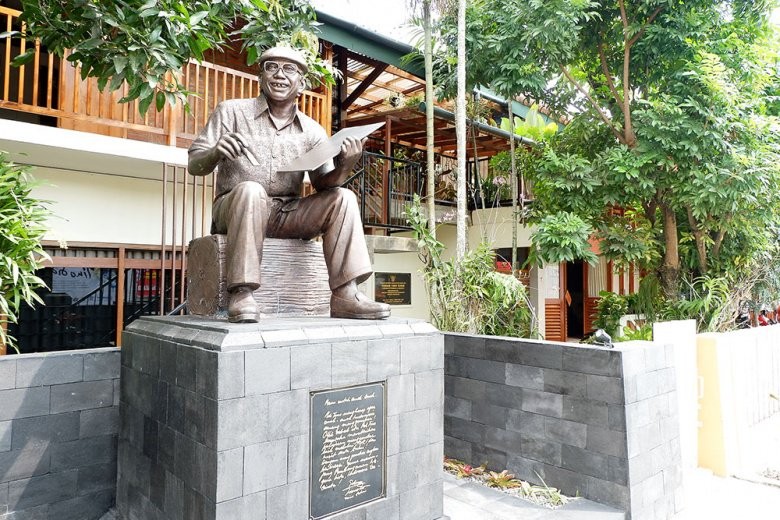Popular Reads
Top Results
Can't find what you're looking for?
View all search resultsPopular Reads
Top Results
Can't find what you're looking for?
View all search resultsYearning for Tino Sidin's 'Ya, Bagus'
Through an ongoing painting exhibition in Yogyakarta, late painter Tino Sidin’s family, friends, students and fans have collaborated to pay tribute to him and his popular catchphrase; “Ya, Bagus (Yes, It’s Nice)”.
Change text size
Gift Premium Articles
to Anyone
Budiati couldn’t hold back her tears while talking about her late father, painter Tino Sidin.
She remembers the day before colon cancer claimed her father’s life at Dharmais Hospital in Jakarta on Dec. 29, 1995. He didn’t appear sick as he chatted and laughed with reporters.
“He was always cheerful,” the 63-year-old said.
Budiati believes that her father is smiling in heaven following the opening of the Tino Sidin Museum on Jl. Tino Sidin in Yogyakarta.
The museum is actually Tino’s house. Before being turned into a museum, it was named Tino Sidin Park.
“At home, he once told us that he wanted to have a park like Ismail Marzuki Park in Jakarta,” Budiati said.
Education and Culture Minister Muhadjir Effendy inaugurated the museum on Dec. 14, on the occasion of which a statue of her father was unveiled along with the opening of an exhibition entitled “Tribute to Tino Sidin” set to run until Dec. 31.
Muhadjir said Indonesia was proud and grateful for Pak Tino, who he said was not only a teacher but also a motivator.
“He is an important figure in developing children’s characters at an early age through art,” the minister said in a statement.
You might not be familiar with Tino if you are a member of Generation Z, a label given to those born after 1995.
Pak Tino, as he was fondly called, was known for Gemar Menggambar (Like to Draw), which he hosted on TVRI every Sunday afternoon from 1979 to 1989.
In the TV program, Pak Tino taught children to draw. He taught children that drawing was fun.
Born on Nov. 25, 1925 in Tebing Tinggi, North Sumatra, Pak Tino was also known for his famous catchphrase, “Ya, bagus [yes, it’s nice]”, which he always used when he commented on drawings and sketches that children had sent to him during Gemar Menggambar shows.
Before airing nationwide in 1979, Gemar Menggambar first aired on local TV station TVRI Yogyakarta, from 1969 to 1978.
Pak Tino had been a teacher since 1951. He first taught at Taman Siswa school in Tebing Tinggi. In 1960, he went to Yogyakarta to study at the Indonesian Academy of Arts (ASRI), which was the first fine arts campus in the country, now known as the Indonesian Art Institute (ISI).
He, however, did not complete his studies at ASRI on account of the 1965 communist purge.
During the ongoing exhibition, more than 50 paintings and sketches are on display. They include paintings by 19 figures, — from Superhero di Dalam Toples (Superhero in Jars) by renowned contemporary artist Heri Dono, Carangan by painter Nasirun, Idola (Idol) by painter Putu Sutawijaya to Bunga (Flower) by Finance Minister Sri Mulyani Indrawati.
For Putu, Pak Tino is an icon who made all children in his era interested in learning art. For Nasirun, he was a legend of TVRI that was close to the hearts and minds of Indonesian children at that time.
Among Pak Tino’s works are the sketch Empat Anak Main (Four Children Play) and paintings Membuat Topeng (Making Mask), Patung Budha (Statue of Buddha) and Kambing-Kambing Mencari Rumput (Goats Look For Grass).
Budiati said Pak Tino’s works were always inspired by simple things. Empat Anak Main, for example, depicted his four daughters.
“While accompanying us while we studied or played, he sketched us. He also sketched my mother,” she said.
Pak Tino, the father of five daughters, rarely got mad, according to Budiati.
“He was friendly and patient. He never scolded us, maybe because we were all girls and not naughty,” she said. “If my mother got mad at us, he always calmed her,” she said.











